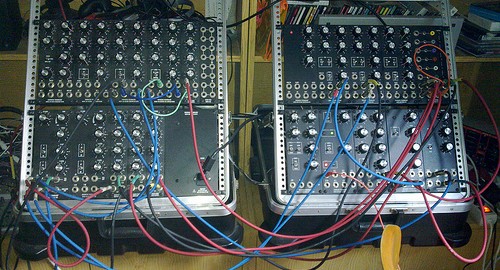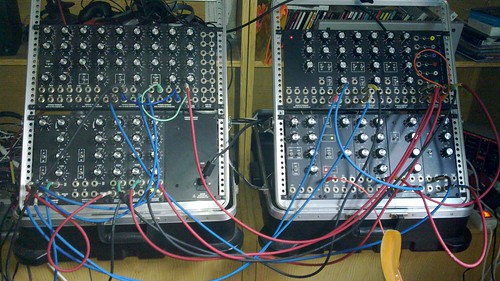Last night, I DJed for the first time ever, at a queer bar in Vauxhall. Bar Wotever is one of my favourite things in London. It’s a friendly, chilled out environment that is a real mix of people. There are LGB people and trans people and the straight and cisgender friends and lovers . It’s every Tuesday. the early DJ starts at 6 (that was me) and plays until 9. then there are usually a couple of stage acts and then another DJ playing dance music.
So my first ever DJ set was 3 hours long! Fortunately, very few people come for 6, so my early n00b errors were largely unwitnessed. It was fun and most of the music I played went down well, except for the one noise piece. Heh. It’s a great piece of music, but the organiser was not into it. This, incidentally, it a reason I write 1-minute pieces. Like, people will usually give you a minute. So if you can write a nice noise piece that’s one minute long, they will give it a shot and may even find they like it. Then it’s like a gateway drug for longer noise pieces. But I digress.
I have a list of everything that I played, but alas, I don’t know what order I played it in! So here’s a list of the songs I played, but totally out of order. If the song title is a link, it leads to where you can download it.
| Song | Artist | Album | Notes |
|---|---|---|---|
| Shy Girl | The Sand Man | Kaos Theory : Live On The Air | trans lyrics, but uses the word “hermaphrodite” for shock value. Not sure what to think. |
| Yusae-Aisae | Wendy Carlos | Beauty in the Beast | trans composer |
| Isis | Whirled Venison | trans composer | |
| Poison 3 | Jess Rowland | The Shape of Poison | trans composer |
| Without a care | M. C. Brennan | trans composer | |
| Chromozones by Amber | Calpernia Addams | Sanitarium Sanctorum | trans artist. I like this song because people make such a big deal about sex chromosomes XX or XY and this takes the piss out that |
| Anticipated | Athens Boys Choir | Bar Mitzvah Superhits Of The 80s, 90s, And Today | trans artist, deals with trans issues |
| last forever (chill mix) | Kim Petras | last forever | trans artist |
| Glorimar’s Whore House (Excerpt) | DJ Sprinkles | Bassline.89 | Trans artist with an unfortunate history of cissexism. |
| Seminole Wind | Gravemist | HEILIGES LICHT presents Landwirtschaft | somebody told me this band has a trans member |
| Just Ask | Adhamh Roland | Patchwork and Threadbare | trans artist. I like this song because ze sings about how ze likes hir body, in a nice alternative to the “trapped in the wrong body” bullocks. This artist is cool. click through. |
| Gender Rebel | Olias Fall | Quandary | trans artist and trans lyrics, but uses the word “hermaphrodite” for shock value. Not sure what to think. |
| Home | Jonathan Rachel Williams | Trans artist. Cool. Has a podcast. | |
| Gender Frontier | Lipstick Conspiracy | Miniskirts and Minibars | trans band. I saw them play in oakland years ago. |
| I Forgot My Mantra | Bitesize | The Best of Bitesize | Band with a trans memeber: Julia Serano, the author of Whipping Girl. This band is awesome! |
| Understudy | Bitesize | Sophomore Slump | |
| Dirty King | The Cliks | Dirty King | awesome band from Canada with a trans front man. Recently voted sexiest Canadian rockstar! |
| Genderfuck | Elmo Sexwhistle | Awesome genderqueer band from Brum! | |
| Stanley, the Manly Tranvestite | Camp Records | From the 1960’s | |
| Are you listening? | dewdrop_world | with the voice of Lady Gaga | |
| Oh, If Only You Were More Nekromantik! | Bolivar Zoar | Bolivar Zoar | A Mills band! |
| Camden Town Rain | Mary Lou Lord | Stars Kill Rock | Lesbian lyrics |
| Rebel Girl | Bikini Kill | Singles | The Joan Jett version |
| Where The Girls Are | The Gossip | That’s Not What I Heard | lesbian lyrics |
| On Guard | Le Tigre | Feminist Sweepstakes | |
| Lésion Mouche | Anatomie Bousculaire | Lésion-Mouche | French lesbian punk rock |
| I Love My Daddy… | Messy | Messy – Happily Ever After | this band is awesome |
| I Wanna Be Your Joey Ramone | Sleater-Kinney | Call The Doctor | 90’s riotgrrl queercore |
| Uncle Phranc | Team Dresch | Captain My Captain | |
| Pansy Twist | Huggy Bear | Taking The Rough With The Smooch | British 90’s riotgrrl queercore |
| It’s Practically Freedom | Lesbians On Ecstasy | We Know You Know | |
| No Home | Ellen Fullman/Konrad Sprenger | Ort | Friends! Good music! |
| Legions (Reverie) | Zoe Keating | One Cello x 16: Natoma | |
| Aaj Ki Raat (Tonight Is the Night) | Kronos Quartet | Kronos Caravan | Music I like form the San Francisco area |
| Polka | Peoples Bizarre | Peoples Bizarre | |
| My Fuzzy Muse | Amy X Neuburg | Residue | |
| Prognissekongen | Jaga Jazzist | One-Armed Bandit | Prog rock – Ingo liked this one |
| 1997 (Tonight we’re gonna party like it’s…) | Sleepytime Gorilla Museum | Grand Opening and Closing! | Oakland-based prog band |
| Mummy Secret Storage | Blectum from Blechdom | De Snaunted Haus | Another Mills band! I took a bunch of music classes with half of this duo |
| 20060401-transplanted | slub | London-based live-coding group. | |
| The Gloaming (DJ Shadow Remix) | Radiohead | ||
| Marine | Diam’s | Au tour de ma bulle (live 2006) | Anti-fascist french hip hop |
| Never | Cold War | Intuition + Method | Friends |
| 5 Million Ways To Kill A CEO | The Coup | Party Music | Oakland based leftist hip hop |
| Girls & Boys | Blur | Parklife | Girls who are boys who like boys when they’re girls . . . this should be the theme song to wotever |
| Fuck The Pain Away | Peaches | The Teaches Of Peaches | This might be the theme song to Wotever. |
There’s some possibility that I might get asked to DJ again. If you’re in a band with LGBT people or sing about LGBT themes and you want me to play you, you should send me mp3s! (This is just a ploy for me to get free music. ) If you are in such a band, you may wish to contact Wotever, especially if you’d like to play a gig.
I did not play every track that I came with, alas, but next time!

